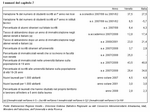7. The figures tell the story
|
Lyceums are becoming increasingly crowded to the detriment of technical and vocational schools. In six years, the number of students signing up for lyceums in Veneto has risen by 37.5% (Italian figure: 27.5%).
The number of students registering at Veneto universities has started to increase again. More than 18,700 first-year students registered for the 2007/2008 academic year, up almost 2% on the previous academic year; the most popular faculties are Economics, Arts and Humanities, and Medicine. The number of young people from other regions and international students is also rising. Last year, 18.4% of the students came from outside Veneto, while 3,900 international students also registered; the latter account for 3.7% of the total number of students, compared with 2.9% in Italy. After a noteworthy increase in first-year registrations in the early years of the university reform, in 2007/2008 the number of Veneto students made up 43.5% of the population aged 19-years old, almost four percentage points lower than the 2001/2002 figure. Overall, more than 111,300 Veneto residents attend university; the majority study in Veneto, but there are many who prefer to go elsewhere. The most coveted destinations among Veneto first-year students are Emilia Romagna and Friuli Venezia Giulia, with the most popular faculties being Law, Engineering and Economics. There are almost 21,600 Veneto graduates, about 59% more than in 2001, equalling over 7% of the national total; the majority have degrees in economics and statistics, or engineering. New graduates often have difficulty finding a job; consequently many young people decide to move away in search of a better future. Five years after graduating a 2008 survey revealed that 89% of Veneto graduates had studied and now worked in their local area, 2.8% worked abroad, almost 7% had moved to another region in the North, and 1.3% to the Centre or the South. (Chapter 7 in figures) |
|
Data processed by the Statistics Office of Regione Veneto are collective property; reproduction of this material is authorised for non-commercial purposes only, provided the source "Regione Veneto - Regional Statistics System Management" is acknowledged.
English translation by the University of Padova Language Centre.



